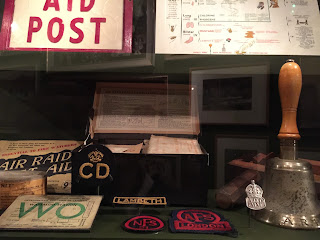 |
| Our first day in Durham |
First, a little history on Durham
University: it’s the third oldest university in England, founded in 1832. Henry
VIII had tried to start a university in London, but obviously, he didn’t get
around to that. Cromwell then tried to issue a charter, but the monarchy and
Oxbridge (Oxford and Cambridge) stopped that. Durham Cathedral eventually
decided to start a university, and the university was born. It’s a collegiate
college, and you have to apply to both the university and the college you want
to be in. The first library was in Palace Green, but it eventually outgrew its
buildings (with expansions taking place all the way into the 1950s), and what
is now the Bryson library became the academic library, with the special
collections remaining at Palace Green.
Bryson Library
The first library we went to in
Durham was the university’s main academic library. Some of the individual
colleges have a library, and there’s the library at Palace Green, but this is
the primary one for students to borrow books from and study in. The library is
at what is called the “science site” – a secondary location for the university
where, as the name suggests, many science programs are headquartered.
 |
| A study area |
The library seemed pretty similar
to university libraries I’ve been to at home, just with more focus on students,
as it seems more students actually take advantage of the library here! There
are 64 loan-able laptops available to students, as well as many digital
resources. There are volume-based study areas around the library – silent,
quiet, group, and surprisingly, a specific area for postgraduate students! My
current school has a specific library for undergrads, but nothing really
specifically saved for grad students. If we had something like this at Wayne, I’d
probably make the trek down to campus more often!
In the lobby, there’s a ping pong
ball poll about the current furniture in the area! I think that’s a fantastic
idea – probably works much better than emailed polls, which most people just
delete.
Palace Green

After our tour of the Bryson library,
we had snacks and tea at a café in the Palace Green library’s building. We were
shown the current exhibit, Somme 1916, which displays some documents and books
from the battle. The impact of the exhibit is measured through written notes
(many in memory of a family member that died during the battle) as well as
(surprisingly!) Twitter.
After that, we went into the
actual Palace Green library’s reading room. It is part of a 1960’s expansion,
and while the exterior of the building blends in very well to the 1400’s
building, you can definitely tell it’s from the 60’s! It reminded me of the
first office of Sterling Cooper from the show Mad Men.
We were quickly shown the
conservation studio, which was designed essentially by the conservators, and
then we went on to Cosin’s library. Originally, it was one of the school’s
libraries – Cosin’s collection was on the ground floor, and the university’s
books were located in the gallery, accessed by a ladder. A staircase wasn’t put
in until the 1850s! Surprisingly, the library contains books that aren’t in the
French national library! It also has a somewhat unique classification system –
there are portraits of authors above where their books are located.
Next, we went into the Bamburgh
Library, named after the Bamburgh Castle Trust. The members of the Sharpe
family gave their books to the university for safekeeping, so this library has
an interesting mix of books. It contains the typical theology, philosophy, and
local history books, but it also has music (located in the cathedral’s library
currently), how to run estate books, books on building lifeboats, and
abolitionist pamphlets. There’s also some bits of the Sudan archives in the
library – a drum is currently being stored in here.
In the dungeon/basement, the
library has a small digitization setup. It has 4 stations, three being an
average size, and one larger one, for maps and similarly sized items. The
current project is the pre-reformation and Benedictine libraries.
Ushaw College
 |
| One of two chapels at the college |
Next, we headed half an hour
outside of town to go to Ushaw College. We got to eat lunch in the parlour,
formerly used as the professor’s dining room. The furniture in the room dates
from the 1860s!
The college itself used to be a
Catholic seminary, which closed its doors in 2011 due to a lack of students.
We were given tours of the two
libraries: the Laurel library, which holds the older books, and the
undergraduate library, which contains modern books.
The Laurel library contains both
books you expect to see in a seminary and secular books. Many of the books were
gained from donations, as well as monastic troubles on the continent. They
still have a card catalogue (which was super exciting to me – I love the
convienence of digital catalogues, but there’s just something about card
catalogues…), and are working on creating a detailed catalogue of the library.
In the undergrad library, despite the closure of the seminary, modern Catholic
materials are still being purchased. It’s also recently been reclassified with
the Dewey Decimal System and many are in the university’s catalogue, resulting
in a leap in inter-library loan requests.
Group photo credits to Dr. Welsh.


















































